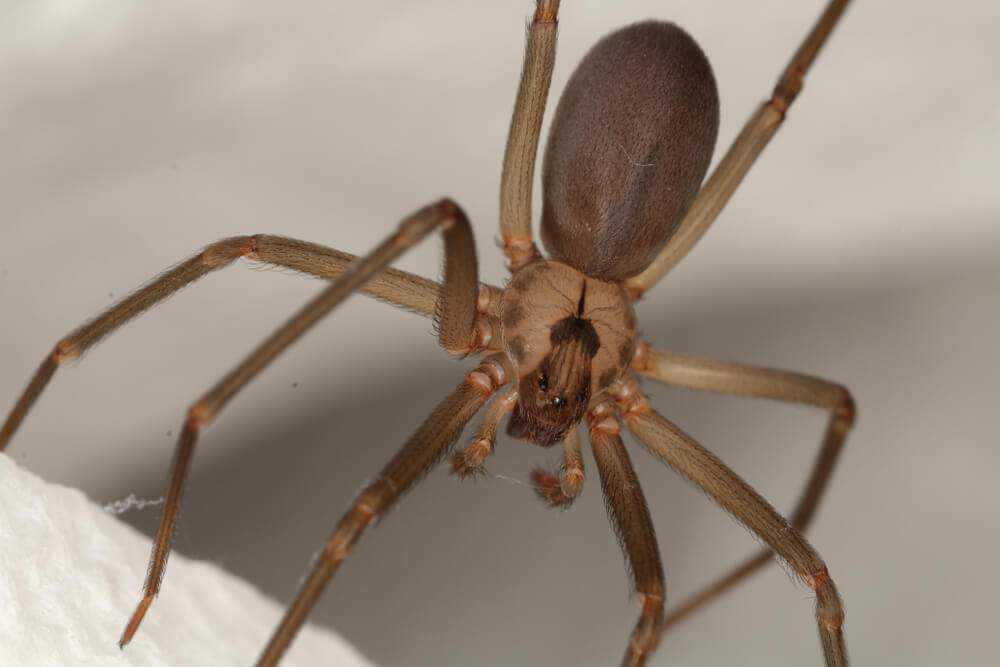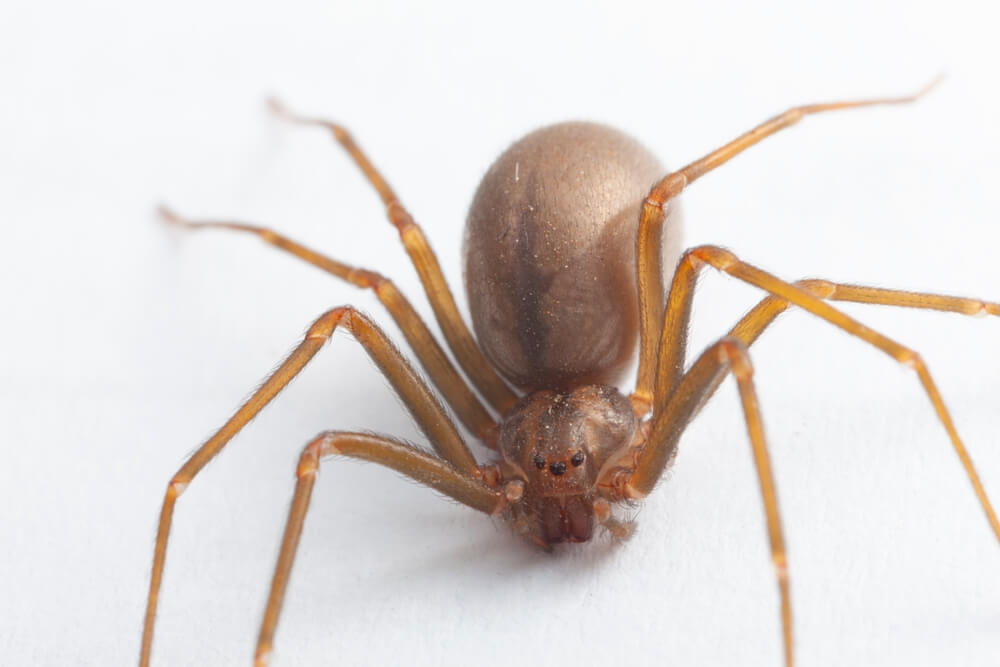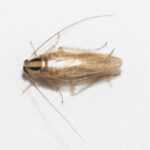The Truth: There Are No Brown Recluse Spiders in Southern California
There are no brown recluse spiders in Southern California. Many people think they are common in the area, but this is a misconception. This article will explain why these spiders aren’t found in Southern California, discuss how they differ from other local spider species, and cover the impact of media myths.
Takeaways
- Brown recluse spiders are not native to Southern California, dispelling common myths and fears surrounding their presence in the area.
- Misidentifications often occur between brown recluse and desert recluse spiders, emphasizing the importance of recognizing their distinct habitats and characteristics.
- Residents should focus on strategies for preventing spider infestations, as effective home maintenance can significantly reduce the risk of dangerous encounters.
Understanding the Brown Recluse Spider
Brown recluse spiders are infamous for their venomous brown recluse bite and the severe reactions they can cause. These brown recluses are part of the Loxosceles genus, known for their reclusive nature and preference for dark, undisturbed areas.
Knowing their physical traits, behavior, habitat, and the effects of their venom helps in understanding these elusive creatures.
Physical Appearance
One of the most distinctive features of brown recluse spiders is the violin-shaped marking on their back, which has earned them the nickname “violin spider”. This marking is dark brown and contrasts with their lighter brown or tan body, making it a key identifier. Additionally, these spiders have a unique eye structure, possessing six eyes arranged in pairs, unlike most spiders that have eight eyes.
Their overall physical appearance includes long, slender legs and a body color that ranges from light tan to dark brown. This coloration allows them to blend seamlessly into their surroundings, making them challenging to spot. The combination of these features often leads to misidentifications with other brown spiders.
Behavior and Habitat
Brown recluse spiders are nocturnal predators, primarily emerging at night to hunt for insects and other arthropods. During the day, they prefer to hide in secluded areas, which can make them difficult to detect. Outdoors, they typically seek shelter in crevices under rocks, beneath dead tree bark, or inside piles of debris. Indoors, they favor dark, undisturbed spaces like closets, attics, basements, and even inside shoes.
Their reclusive nature extends to their interactions with humans. Brown recluse spiders generally avoid human contact, preferring to remain hidden. However, when their hiding spots are disturbed, they may bite in self-defense. Knowing their habitat and behavior aids in identifying and avoiding potential encounters with these spiders.
Venom and Medical Impact
The venom of a brown recluse spider is particularly potent, containing a compound called sphingomyelinase D, which can cause significant skin damage and necrosis. A brown recluse spider bite often results in severe pain, redness, and swelling at the bite site, followed by the development of a necrotic lesion. In some cases, the venom can cause systemic reactions, leading to symptoms such as fever, chills, and nausea.
If bitten by a brown recluse spider, seek immediate medical attention to manage symptoms and prevent further complications. The medical community recognizes the seriousness of loxoscelism, the condition caused by brown recluse bites, and stresses the importance of timely intervention.
Geographic Range of Brown Recluse Spiders

Brown recluse spiders are not the pervasive threat in California that many believe them to be. These spiders are primarily found in the Midwest and South-Central regions of the United States. Contrary to popular belief, brown recluse spiders are not part of the Californian spider fauna, and their presence in California is virtually non-existent.
Native Regions
The brown recluse spider’s native habitat is concentrated in specific regions of the United States, particularly in the Midwest and South-Central areas. These regions include 16 states such as Texas, Missouri, and Tennessee, where brown recluse spiders are commonly found. The spiders thrive in undisturbed areas, often inhabiting dark, secluded spots both indoors and outdoors.
In these states, brown recluse spiders prefer environments that provide ample hiding places, such as old buildings, woodpiles, and sheds. Their presence in these regions is well-documented, and they are an integral part of the local spider fauna.
Misidentifications in California
In California, many people mistakenly identify other brown spider species as brown recluse spiders due to their similar appearance. The desert recluse spider, which is more common in California, is often confused with the brown recluse because of their shared physical characteristics. This confusion leads to frequent misdiagnoses of spider bites in Southern California, attributing them to brown recluse spiders when they may stem from other conditions.
Most Californians are unaware that the desert recluse is the most frequently encountered recluse spider in the state. This misidentification issue is compounded by the fact that both the desert recluse and the brown recluse have six eyes arranged in pairs, differing from the typical eight eyes found in other spiders.
The Role of Media and Myths
Media coverage often exaggerates the prevalence of brown recluse spiders in California, leading to widespread misconceptions. Sensationalized reports and public anxiety have contributed to the false belief that brown recluse spiders are a common threat in the state. These myths perpetuate fear and misunderstanding, causing unnecessary panic among residents.
Knowing the true geographic range of brown recluse spiders and recognizing the role of media in spreading false information helps dispel these myths. By focusing on accurate information and education, we can better address the real spider threats in California.
Desert Recluse Spiders: The Real Threat in Southern California
While brown recluse spiders are not a concern in California, the brown and desert recluse spider poses a real threat in Southern California. Often mistaken for the brown recluse, the desert recluse is a distinct species that shares many physical characteristics with its more infamous cousin.
Recognizing the similarities and differences between these two species is key for accurate identification and proper response to bites.
Similarities and Differences
Desert recluse spiders and brown recluse spiders share similar physical features, such as body shape and coloration, which can lead to misidentification. Both species have a violin-shaped marking on their back, long slender legs, and six eyes arranged in pairs. These similarities cause confusion among people encountering these spiders, leading to increased reports of brown recluse bites in areas where only desert recluse spiders are present.
The main difference between the two species lies in their geographic distribution. While brown recluse spiders are native to the Midwest and South-Central United States, desert recluse spiders are found in arid regions like the Sonoran and Mojave deserts. Recognizing these differences is key to accurately identifying and managing encounters with these spiders.
Habitat and Distribution
Desert recluse spiders thrive in arid regions, particularly in the Sonoran and Mojave deserts. They are often found in natural habitats near native vegetation rather than urban settings. These spiders are particularly abundant in packrat dens, indicating a preference for specific ecological niches.
In Southern California, desert recluse spiders are more likely to be encountered in rural and semi-rural areas where their natural habitats are preserved. Knowing their preferred habitats can help avoid encounters and manage their presence effectively.
Venom and Bite Effects
A bite from a desert recluse spider can be serious, potentially sending the victim to the hospital. The venom of desert recluse spiders can cause significant effects on humans, including pain, swelling, and necrosis at the bite site. While the venom’s effects may differ from those of the brown recluse, they still require proper identification and medical treatment.
Identifying the symptoms of a desert recluse bite and seeking immediate medical attention is essential in managing the effects of the venom. Proper education and awareness can help reduce the risk of severe reactions and complications.
Other Dangerous Spiders in Southern California
In addition to the desert recluse spider, residents of Southern California should be aware of other dangerous spiders, such as black widow spiders. These spiders also pose significant risks, and understanding their characteristics and habitats can help in preventing and managing encounters.
Black Widow Spiders
Black widow spiders are recognizable by their dark black bodies and the bright red hourglass marking on their abdomen. Unlike brown recluse spiders, black widows have eight eyes, which can help in distinguishing them from other species. They typically build their webs indoors in dark, cluttered, and secluded areas such as basements and garages.
A bite from a black widow spider can cause severe pain, muscle cramps, and other systemic symptoms, making it crucial to seek medical attention immediately if bitten. Knowing their habits and recognizing their distinctive markings can help avoid dangerous encounters.
Brown Widow Spiders
Brown widow spiders have a mottled tan and brown appearance with an orange hourglass marking on their abdomen. They are less aggressive than black widow spiders, but their bites can still cause significant discomfort and require medical attention.
These spiders prefer dark, undisturbed areas similar to black widows and can often be found in outdoor structures like sheds and under patio furniture. Identifying the differences between black and brown widow spiders can aid in managing and preventing encounters with these dangerous arachnids.
Preventing Spider Infestations in Your Home

Preventing spider infestations is key to keeping your home safe from dangerous spiders like the desert recluse and black widow spiders. Knowing effective strategies for pest control and home maintenance can significantly reduce the risk of encountering these spiders indoors.
Home Maintenance Tips
Sealing cracks and holes in walls and around doors is essential to prevent spiders from entering the home. Gaps around windows and doors should also be sealed to keep spiders out. Regular cleaning to remove clutter and spider webs can significantly deter spider infestations.
Keeping outdoor lighting to a minimum can reduce the number of insects that attract spiders, and scheduled pest control services can help maintain a spider-free environment throughout the year. Professional pest control services often include perimeter treatments to reduce spider populations outside your home.
Brown recluse spiders are not a threat in Southern California, but the desert recluse spider is. Understanding the differences between these species, recognizing other dangerous spiders like black widow and brown widow spiders, and taking preventive measures can help keep your home safe. Stay informed, stay vigilant, and take action to protect yourself and your family from spider threats.
Frequently Asked Questions
Are there brown recluse spiders in California?
Brown recluse spiders are not found in California, so you can rest easy! The desert recluse is the common recluse spider in the area.
How can I identify a brown recluse spider?
To easily identify a brown recluse spider, look for a signature violin-shaped marking on its back and remember they have six eyes arranged in pairs. Stay vigilant, and you’ll be able to recognize them quickly!
What should I do if I get bitten by a spider in California?
If you get bitten by a spider in California, seek immediate medical attention to ensure your safety, especially if it might be a desert recluse or black widow. Your health is a priority, so don’t hesitate to get help!
How can I prevent spider infestations in my home?
To prevent spider infestations, seal any cracks and holes, keep your home clean and clutter-free, and reduce outdoor lighting. Taking these steps will help create an inhospitable environment for spiders!
What are the symptoms of a desert recluse spider bite?
A desert recluse spider bite can cause pain, swelling, and can even lead to necrosis at the bite site. Remember, seeking medical attention promptly is crucial for the best outcome!





